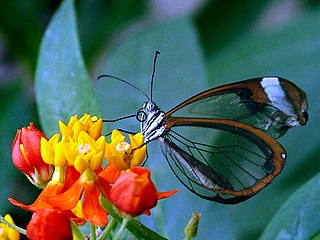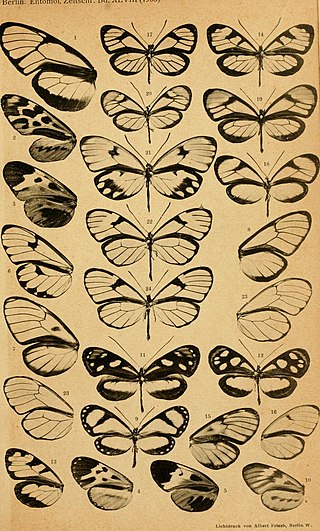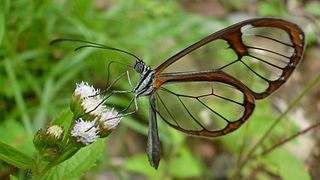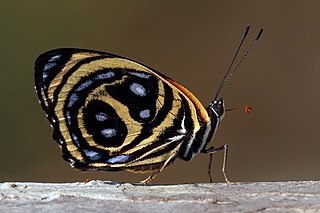
William Chapman Hewitson was a British naturalist. A wealthy collector, Hewitson was particularly devoted to Coleoptera (beetles) and Lepidoptera and, also, to birds' nests and eggs. His collection of butterflies, collected by him as well as purchased from travellers throughout the world, was one of the largest and most important of his time. He contributed to and published many works on entomology and ornithology and was an accomplished scientific illustrator.

Agrias is a genus of Neotropical charaxine nymphalid butterflies found in South and Central America.

Greta is a genus of clearwing (ithomiine) butterflies, named by Arthur Francis Hemming in 1934. They are in the brush-footed butterfly family, Nymphalidae, and are found in Central America, South America, and the Caribbean.

Deudorix is a large genus of butterflies in the family Lycaenidae. The species of this genus are found in the Old World and Australia.

Episcada is a genus of clearwing (ithomiine) butterflies, named by Frederick DuCane Godman and Osbert Salvin in 1879. They are in the brush-footed butterfly family, Nymphalidae.

Oleria is a genus of clearwing (ithomiine) butterflies, named by Jacob Hübner in 1816. They are in the brush-footed butterfly family, Nymphalidae.

Hypoleria is a genus of clearwing (ithomiine) butterflies, named by Frederick DuCane Godman and Osbert Salvin in 1879. They are in the brush-footed butterfly family, Nymphalidae.

Emesis is a Neotropical genus of butterflies.

Ithomia is a genus of clearwing (ithomiine) butterflies, named by Jacob Hübner in 1816. They are in the brush-footed butterfly family, Nymphalidae.

Hypothyris lycaste is a species of butterfly of the family Nymphalidae. It is found in Central and northern South America.

Godyris is a genus of clearwing (ithomiine) butterflies, named by Jean Baptiste Boisduval in 1870. They are in the brush-footed butterfly family, Nymphalidae.

Napeogenes is a genus of clearwing (ithomiine) butterflies, named by Henry Walter Bates in 1862. They are in the brush-footed butterfly family, Nymphalidae.

Pteronymia is a genus of clearwing (ithomiine) butterflies, named by Arthur Gardiner Butler and Herbert Druce in 1872. They are in the brush-footed butterfly family, Nymphalidae.

Heterosais is a genus of clearwing (ithomiine) butterflies, named by Frederick DuCane Godman and Osbert Salvin in 1880. They are in the brush-footed butterfly family, Nymphalidae.

Velamysta is a genus of clearwing (ithomiine) butterflies, named by Richard Haensch in 1909. They are in the brush-footed butterfly family, Nymphalidae.
Pagyris is a genus of clearwing (ithomiine) butterflies, named by Jean Baptiste Boisduval in 1870. They are in the brush-footed butterfly family, Nymphalidae.

Napeogenes sylphis is a species of butterfly of the family Nymphalidae. It is found in South America.

Melanis is a genus in the butterfly family Riodinidae present in the Neotropical realm.

Pseudoscada erruca is a South-American species of brush-footed butterfly in the Godyridina subtribe of Ithomiini. It was described in 1855 by William Chapman Hewitson as Ithomia erruca.

Callicore texa, the yellow-rimmed eighty-eight or the texa eighty-eight, is a species of butterfly of the family Nymphalidae. The common name refers to the markings on the underside of the hindwings, which resemble the number "88". The species is found from Mexico south to Colombia.



















